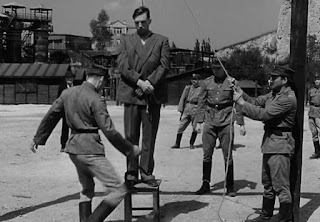The long march
On 19 July 1944, Adolf Hitler issued an order from his headquarters, Wolfsschanze, 100 miles west of Stalag Luft VI, "concerning preparations for the defense of the Reich". It put the German civilian population on a total war footing and issued instructions for preparations for evacuations of 'foreign labour’ (slave labour) and civilians away from the advancing Soviet Army in the east.
called for "preparations for moving prisoners of war to the rear". This prolonged the war for hundreds of thousands of Allied personnel, as well as causing them severe hardship, starvation, injuries and/or death. In the later stages of the war there were great concerns among POWs over the motives for moving them westward. Many different and conflicting rumours abounded, including suggestions that:
They were being moved towards concentration camps to be killed, in revenge for Allied commanders' deliberate targeting of civilians, in cities such as Dresden. These events were also the origin of one of the German terms for Allied bomber crews: terrorflieger ("terror aviators").
POWs would be force-marched until their deaths from exhaustion, a practise that had already been made notorious by the Japanese military (see, for instance: Bataan Death March).
They would be held hostage to leverage peace deals, including claims that they would be held at a national redoubt in the Alps.
This claim was backed up by SS General Gottlob Berger, who was appointed general commander of POW camps during 1944. Berger stated during his trial for war crimes (1948), that Hitler had considered a threat to execute 35,000 POWs, unless the Allies agreed to a peace deal. Similarly, SS chief Heinrich Himmler had made similar plans, centred on the Baltic coastal region and set up a new headquarters in a castle on the Bay of Lübeck.
In most camps, the POWs were broken up in groups of 250 to 300 men and because of the inadequate roads and the flow of battle, not all the prisoners followed the same route. The groups would march 20 to 40 kilometers a day - resting in factories, churches, barns and even in the open. Soon long columns of POWs were wandering over the northern part of Germany with little or nothing in the way of food, clothing, shelter or medical care.
Prisoners from different camps had different experiences: sometimes the Germans provided farm wagons for those unable to walk. There seldom were horses available, so teams of POWs pulled the wagons through the snow. Sometimes the guards and prisoners became dependent on each other, other times the guards became increasingly hostile.
Passing through some villages, the residents would throw bricks and stones, and in others, the residents would share their last food. Some groups of prisoners were joined by German civilians who were also fleeing from the Russians. Some who tried to escape or could not go on were shot by guards.
With so little food they were reduced to scavenging to survive. Some were reduced to eating dogs and cats—and even rats and grass—anything they could lay their hands on. Already underweight from years of prison rations, some were at half their pre-war body weight by the end.
Because of the unsanitary conditions and a near starvation diet, hundreds of POWs died along the way from exhaustion as well as pneumonia, diphtheria, pellagra, and other diseases. Typhus was spread by body lice. Sleeping outside on frozen ground resulted in frostbite that in many cases required the amputation of extremities.
In addition to these conditions were the dangers from air attack by Allied forces mistaking the POWs for retreating columns of German troops. On April 19, 1945, at a village called Gresse, 30 Allied POWs died and 30 were seriously injured (possibly fatally) in a "friendly-fire" situation when strafed by a flight of RAF Typhoons.
As winter drew to a close, suffering from the cold abated and some of the German guards became less harsh in their treatment of POWs. As the columns reached the western side of Germany they ran into the advancing western Allied armies. For some, this brought liberation. Others were not so lucky.
They were marched towards the Baltic Sea, where Nazis were said to be using POWs as human shields and hostages. It was later estimated that a large number of POWs had marched over five hundred miles by the time they were liberated, and some had walked nearly a thousand miles.











Comments
Post a Comment